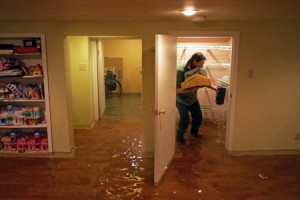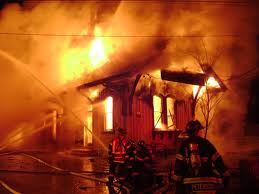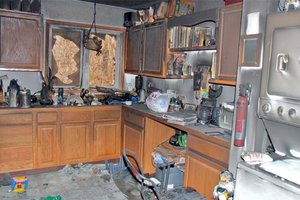Flower Mound Roofing – Hail Damage Part 3
Flower Mound Roofing – Hail Damage Part 3
by Kenton Shepard and Nick Gromicko
Let’s take a look at the different factors which determine how severe hail damage can be.
Hail damage has certain characteristics which vary with both the different properties of hail, and with the properties of the various roofing materials that hail hits. First, let’s examine the different properties of hail.
The severity and appearance of the damage caused by hailstones depends on a number of variables. The size, density, free-fall velocity, the shape of the hail, its directionality, and angle of impact can all affect the damage you see during an inspection.
IMPACT ENERGY
Three of these properties — size, density, and free-fall velocity — affect what’s referred to as the “impact energy” of hail. Impact energy is the amount of energy transferred to the roof-covering material when the hailstone strikes. Impact energy is the most important factor influencing the severity of damage caused by a hailstone. A hailstone carrying a lot of impact energy will do more damage than one carrying less impact energy.
Size
Size is an important factor because larger hailstones are heavier and fall faster than smaller hailstones, and so they carry more impact energy.
Natrional Center for Atmospheric Research
The largest hailstone ever recorded in North America fell in Aurora, Nebraska in 2006.
Hail size is described by comparing it to a common object. Here are some commonly used descriptions:
- pea = 1/4-inch in diameter;
- marble = 1/2-inch in diameter;
- dime or penny = 3/4-inch in diameter (hail the size of a penny or larger is considered severe);
- nickel = 7/8-inch;
- quarter = 1 inch;
- golf Ball = 1½ inches;
- tennis Ball = 2½ inches;
- baseball = 2¾ inches;
- tea cup = 3 inches; and
- grapefruit = 4 inches.
TABLE 1
|
Material |
Hail Size |
Damage |
|
3-tab organic shingles |
1-inch |
25mm |
|
3-tab fiberglass shingles |
1¼-inch |
32mm |
|
cedar shingles |
1¼-inch |
1¼-inch |
|
fiber-cement tiles |
1¼-inch |
1¼-inch |
|
flat concrete tiles |
1¼-inch |
1¼-inch |
|
heavy cedar shakes |
1½-inch |
38mm |
|
30-year laminated shingles |
1½-inch
|
1½-inch
|
|
built-up gravel roofing |
2-inch |
50mm |
|
S-shaped concrete tiles |
2-inch |
2-inch |
Three-tab fiberglass, cedar shingles, fiber cement, and flat concrete tiles may begin to suffer damage when hail reaches about 1¼-inch in diameter.
Concrete S-tiles can start showing damage when hail reaches about 2 inches.
The size of a hailstone is determined by the number of ice layers it accumulates before it falls to the earth. Larger, more powerful storms with strong winds may keep hailstones aloft long enough for them to reach large sizes.
It can be difficult to tell the size of a hailstone by the damage it leaves.
Damage left by hailstones of the same size can vary, depending on the hailstones’ density, their angle of impact, and the properties of the material they hit.
It’s also common for the size of hailstones to vary within a single storm. Hailstones at the leading and trailing edges of storms may be of a size different from those in the main body of the storm, so it’s not unusual to see damage to a property with characteristics of different sizes of hailstones.
When discussing the importance of impact energy and the characteristics of hailstones, size is the easiest to estimate. You can’t tell the density or free-fall velocity of a hailstone by looking at the damage it leaves behind. But as you become more experienced at inspecting hail damage, you’ll become more skillful at judging the size of the hailstone by looking at the damage to a variety of materials.
Hard hailstones hitting soft, thin materials, such as aluminum vents, will leave a better indication of their diameter than soft hailstones hitting hard materials.
You don’t really need to determine the actual size of the hailstone. Your mission is to identify functional damage, or the lack of damage. Size is just one more clue.
Larger hailstones tend to be less spherical. They often grow not only by gaining ice layers, but also by colliding and merging with other hailstones.
National Center for Atmospheric Research
As hailstones collide, they can form odd, asymmetrical shapes, as you can see here. Each of these lobes was once an individual hailstone.
Although recognizing damage from huge hailstones is easy, recognizing what is and isn’t damage from smaller, softer hail can be much more difficult.
No need to struggle deciding which repairs you will make to your Flower Mound Roofing Damage- you have enough to think about. Your insurance will cover the cost of your Flower Mound roofing repairs. We are the Flower Mound roofing company that knows the complete ins and outs of what needs to be done to completely take care of your Flower Mound roofing repair At Go Go Green Roofing and Solar we will take care of the whole insurance process for you. Call us today at (682) 325-2682 for your free evaluation.





